November 19, 2021 Leave a Comment
Bring back memories of your childhood by introducing your children to traditional Indian games that we played when we were kids ourselves!
Life has changed drastically with the information revolution, with a large part of learning moving online, even before the pandemic. The result is an entire generation of children and teenagers who are glued to screens, with many of them being out of touch with what’s happening in the outside world.
As consumerism has also increased, we get our kids more and more toys and gadgets, but after a point, nothing seems to please them. Despite having everything, they end up bored and restless, and we’re left wondering what else we can do for them


Have you ever considered not doing anything?
Think about our own childhoods. We never had these fancy gadgets or expensive toys, yet we found plenty of ways to stay occupied and were rarely bored. In fact, we were rarely home – we were always outside, playing with our friends and neighbors!
Maybe that’s exactly what our kids need today – some plain simple fun with other children, without any costly equipment. And that’s why it’s a good idea to go back to our traditional Indian games, the ones we grew up with and which gave us special memories.
Think those games are too old fashioned for today’s young crowd? Think again! Here are some of the benefits of introducing your kids to traditional Indian games:
- Most of these games promote physical movement, something today’s children are severely lacking
- These games require children playing with others, often in teams, promoting better social skills
- These games connect kids to their culture and to their parents’ childhoods
- The games often require little to no equipment, meaning there is no expense involved
- Children from all families, religions and socio-economic backgrounds can play together
- The rules for these games are quite simple and basic, so kids can focus on having fun
Now that you’re convinced, let’s look at 20 traditional Indian games that today’s kids should know. There are many more, but we chose the most common ones for now.
20 Traditional Indian Games for Today’s Kids

1. Hopscotch
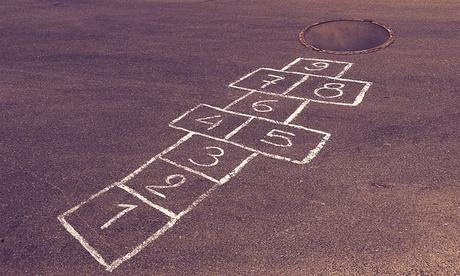
Hopscotch was one of my personal favorites growing up, and I remember boys and girls playing it, although in some places it’s more popular with young girls. This game is also known as nondi, stapoo or kith kith. A grid is drawn on the ground using chalk, with numbers marked inside the squares. A flat stone or piece of tile is used to toss within the grid and the players have to hop all the way to the square containing their tile, pick it up and make their way back, hopping all the while. This game is an excellent physical exercise, as hopping on one leg can raise the heart rate quite a bit. It also requires good balance and co-ordination as players try to keep their fit within the lines of the grid.
2. Kho Kho
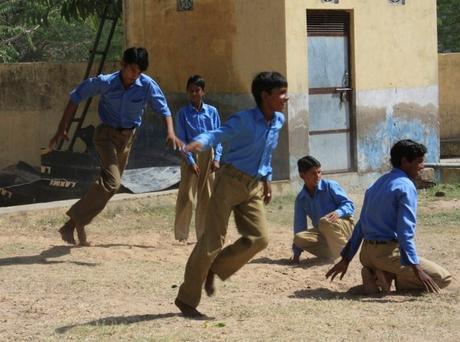
Kho kho is a team game and is popular in schools and when you have a large gathering. It is an Indian version of ‘Run Chase’, a game that involves running behind a player to touch him or her. The available players are split into two teams and the first team sits on the ground, with each player facing opposite directions alternately. The other team runs around this group, trying to avoid being touched by their opponents. Sometimes, there is a time limit during which all players need to be touched and ‘eliminated’.
3. Marbles

I can still remember how much fun we had playing marbles when we were kids! It’s amazing how something so simple can give hours of joy and laughter. Playing marbles is also known as goti, golli, lakhoti or kancha. This game is believed to have originated during the Harappan age. The glass marbles used in the game are easily available and inexpensive, which meant that everyone could play with them. There are many games with marbles, but most of them involve striking a marble using another with a specific strike technique. While this game doesn’t require too much physical movement, it does need good focus and concentration.
4. Gilli Danda
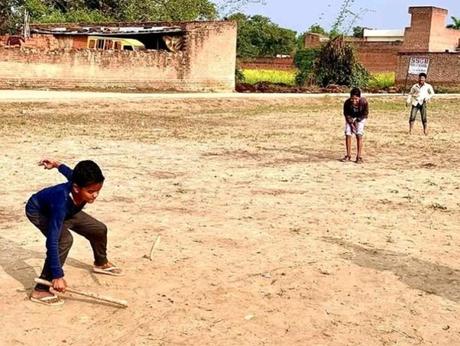
This game has become almost synonymous with playing on the streets in India. Gilli Danda indicates the use of a Gilli, a short stick, and a Danda, which is a longer stick. The game is similar to cricket but far less complicated. The Danda is used to flick the Gilli up from the ground and then strike it while it’s still in the air. Right after hitting the Danda, the player needs to run to a certain point before the Gilli is caught by the opponent. Any number of players can play the game, and it’s a good exercise in hand-eye coordination, reflexes and speed.
5. Pallanguzhi
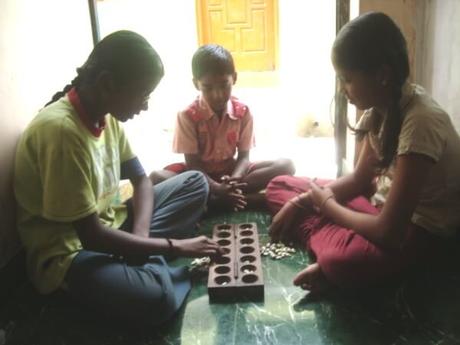
This game is popular in South India, and is also known as Kuzhipara, Guli Mane, Picchala Peeta or Vamana Guntalu. This is one of the few games in this list that requires a special board to play. The board has two rows of little cups in seven columns, into which you place the counters, which are often cowrie shells or tamarind seeds. The game starts with 12 counters in each cup. The first player needs to move all the shells from one cup to the other cups, moving in a clockwise direction. When their cups are done, they move to the opponent’s cups till their counters are finished. They then continue the game by picking the counters from the next cup. When the last counter falls in a cup with an empty cup beyond it, it’s the turn of the next player. When the last counter lands in a cup that has two empty cups ahead, the game ends.
6. Lagori
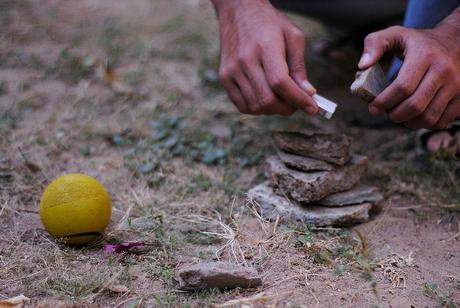
This is a game that sits close to Gilli Danda as one of the most popular street games in India. You may have also heard of this game as Pittu, sitoliya, or lingocha. The game is simple enough and all you need is a stack of stones and a ball. Stones with a large, flat surface are preferred so they can be stacked one on top of another. The game is played in teams, and each player gets three turns to knock down the pile of stones with the ball. The rest of the team has to try to put the stack together before getting hit by the ball. It’s a fun game which truly celebrates team spirit and promotes a sense of bonding among members of the team.
7. Kabaddi
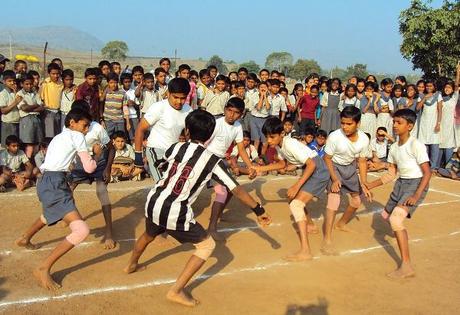
Kabaddi is more of a sport than a game, and a nail-biting one at that! The game is played with two teams and requires absolutely no equipment at all. A player from each team tries to break into the opposing team’s area by touching as many players of the opposite time while touching the border line. The ‘touched’ players are declared out, and the team with the least number of players wins the match. This game is a test of strength, agility as well as strategy and keeps everyone fully focused on the game.
8. Antakshari
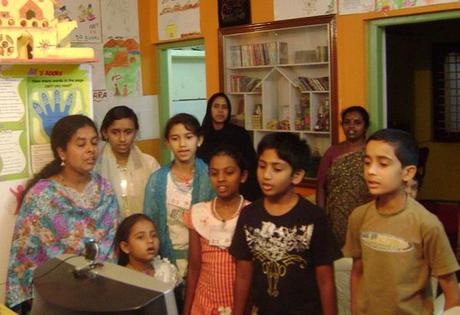
No Indian family gathering is complete without a few rounds of Antakshari! This is a game that has stood the test of time, and while it’s not played as frequently as before, it’s still pretty popular. You’ll also find strangers on trains enter a random game of Antakshari to kill time during a long journey. Antakshari requires two teams with any number of members. One team sings a song and the other team has to start where the first team leaves off, taking the last letter of the song to begin their round. The game can go on for as long as you like and is basically a great bonding opportunity, forcing even uptight people to loosen up and participate.
9. Pachisi
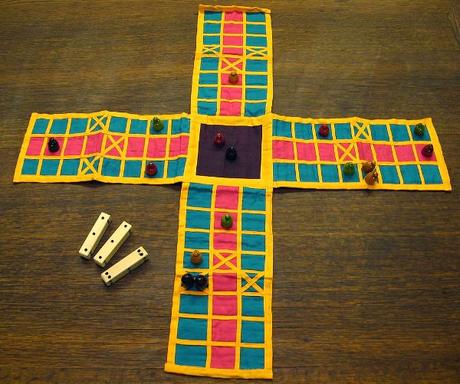
Pachisi, also known as Chaupar, is a board game that is prominent because it features in the Mahabharata, and is also known to be one of the games the Mughal kings enjoyed playing. This game is probably one of the oldest among traditional Indian games, believed to have been invented in the 14th century. It is quite similar to the modern Ludo. The game is played by four players and requires a special cross-shaped board made of fabric. The counters or pawns are usually cowrie shells. The center of the board is considered ‘Home’ and each player has to ensure that all his or her pawns reaches home before the others, moving in an anti-clockwise direction. This game involves a good deal of strategy and planning, and is perfect for all ages.
10. Chhuppan Chhuppai
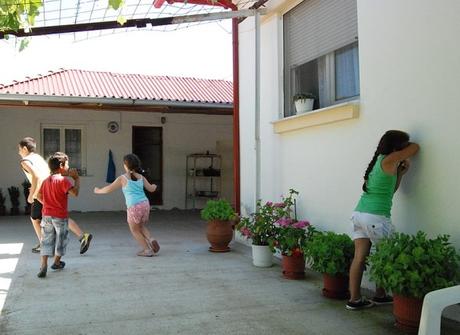
Chhuppan Chhuppai is basically Indian Hide and Seek, and the rules are pretty much the same. This is a game that is probably played all across the world, and known by different names. This is also an equipment-free game, and all you need is some space to play and hide. One person is chosen as the denner, and is expected to count to hundred with his eyes shut, before setting out to find the others who’ve hid. The first person to be found becomes the next denner and the game goes on. It’s a game that involves planning, finding the ideal place to hide or trying to figure out where the others have hidden.
11. Maram Pitthi
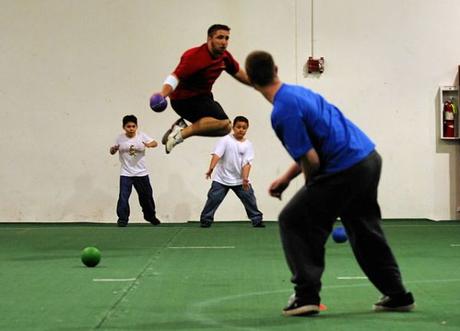
Maram Pitthi is India’s answer to dodgeball. All that is required to play this game is a large open space and a ball, along with two teams of players. One team tries to hit the other players with a ball, and every player who is hit is out of the game. The hitting transfers to the team who gets rid of all the players. It’s a game that is a lot of fun, involves a lot of movement as well as some hand eye coordination and good reflexes.
12. Gutte

This game has many variations across the country, and is a popular one among traditional Indian games. It is also known as Anchankal or Kallankal, especially among the Southern states. The game involves five stones, preferably with a smooth surface. A player tosses a stone into the air and picks up another stone from the ground and tries to catch the first one before it reaches the ground. The process continues till a stone hits the ground and then the next player gets a turn. The game involves a good deal of hand-eye co-ordination, concentration, speed and reflexes. The game gets challenging as it progresses, and also a lot more fun!
13. Lattu
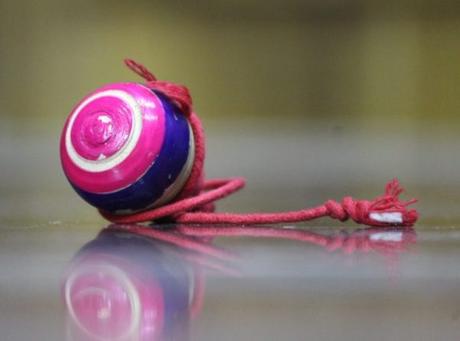
The lattu is a spinning top, and that is exactly what you need to play this game! The game is really simple – it is just to find out who can make the top spin for the longest. However, the top is unique – it has a rope which needs to be wrapped around the top and pulled to make it spin. The top is made from many materials, including clay and wood. Modern tops also have light and sound effects. Some people add their own twists to the game, like lifting the top off with the string and others.
14. Ashtapada
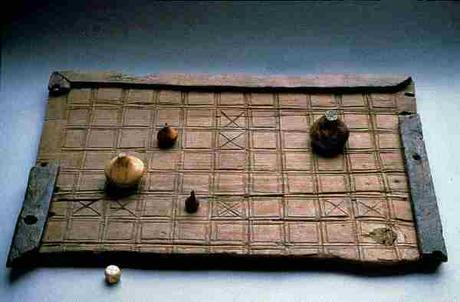
Ashtapada is a board game with a board that’s divided into 8×8 squares, like a chess board. However, all the squares here are the same color, and the dice is what guides the game’s progress. Some of the squares on the board have special markings on them and are called castles. The game starts with each player having a certain number of pieces, and the pieces can be moved in a clockwise direction, with the aim to reach the castle. There is another version of the game played on a 10×10 board, called Dasapada.
15. Chaturanga
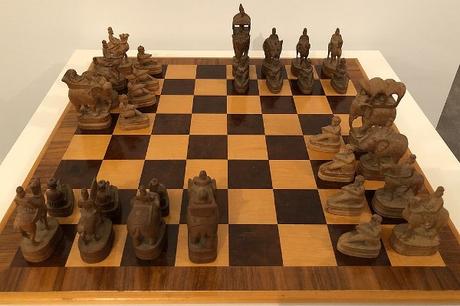
Chaturanga is considered the official predecessor of modern chess, as well as other strategy games like Xiangqi, Shogi, and Makruk. The board used in this game is the same as the one used in Ashtapada. Like chess, the game has two players and each player has a set of pieces – the King, General, Rook, Elephant, Horse and Pawn. Each piece has a set of rules regarding its movement on the board, and the aim is to trap the king of the opponent. It’s an excellent strategy game, and is great for increasing focus and concentration.
16. Posham Pa
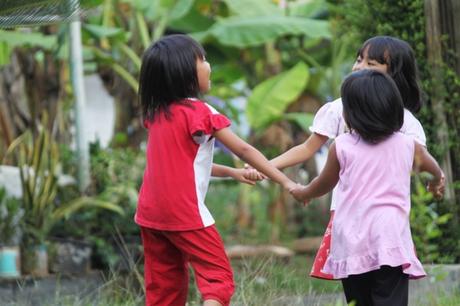
This game is similar to another one known as ‘Oranges and Lemons’. This is a game that is usually played outdoors, although you can play indoors if you have sufficient space. Two players join both hands and lift it up to form a gateway. The other players have to pass through this gate. The first two sing a song while they hold their hands up, which can be any song – the ‘Oranges and Lemons’ nursery rhyme is a popular choice. When the song ends, they put down their hands and the player inside gets trapped. The basic concept of the game is similar to that of musical chairs, when one player gets eliminated at the end of every song. This is a fun game for younger kids, as it does not include much effort beyond singing a song.
17. Vish Amrit

This game is similar to Lock and Key, a popular game we played when we were kids. It’s a very simple game that has just one goal – run and catch the next person! One child is designated the denner who has to run behind the others and try to catch whoever is nearest, saying ‘Vish’ while touching them. The caught player is now frozen and can only be released when another player touches him saying ‘Amrit’. It is a fun game that involves lots of running and chasing, and also develops kids’ spatial skills as they try to decide who the nearest person is.
18. Aankh Micholi
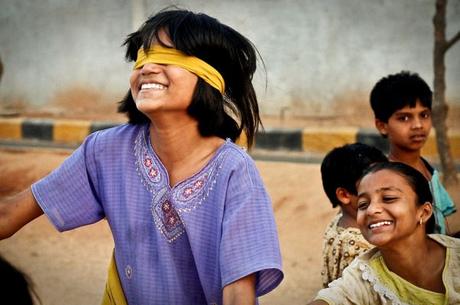
Aankh micholi is basically Blind Man’s Buff, a game that is popular throughout the world among people of all ages. Here, a player is blindfolded and has to catch the other players who run around him. There are many variations to this game; in some versions, the blindfolded player is asked to turn around in circles three times so they lose their orientation and to make the game more challenging. In other versions, the other players yell as they move around, making the blindfolded player more confused! This game is great for developing sensory skills and focus, while also strengthening spatial and directional skills.
19. Carrom

You can’t have a list of traditional Indian games without listing Carrom, a game that originated in India! This is one of the most popular games among all generations, and even today you’ll find senior citizens hunched about a carrom board. For this game you’ll need a carrom board and carrom men, of course, as well as a sturdy surface to place the board on. The aim is to gather as many points as you can, and each color of the carrom men represent different points, with the queen being the most prized one. Playing carrom doesn’t require too much physical exertion, but it does require a bit of dexterity, hand eye coordination, focus and math, as you calculate points after every move.
20. Kokla Chapaki
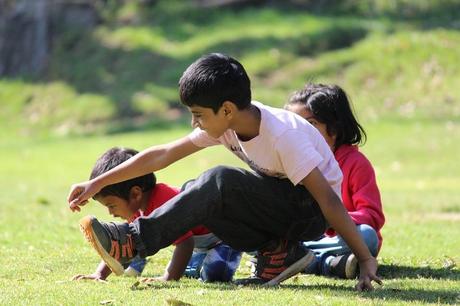
This game has its origins in Punjab, but it is also known as the Drop the Handkerchief game in other parts of the world. All you need for this game is a handkerchief or simply a piece of cloth. One player starts the game, while the others sit on the ground forming a circle. The first player runs around this circle with the handkerchief and drops it behind any one in the circle. This person now picks up the handkerchief and chases the first player, who tries to occupy the vacant spot in the circle before being caught. The running player often sings a song as he runs, and it can be any traditional song from your region. It’s a game that requires the players to be alert at all times, while also improving their speed in sitting, standing and running.
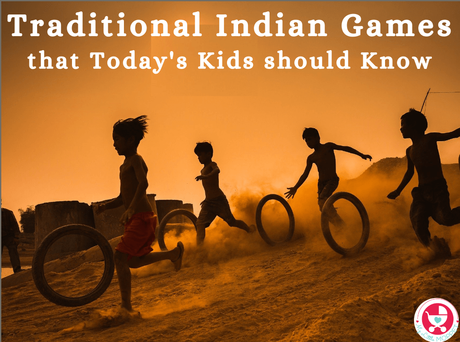
You may also like
- Your Guide to Traditional Indian Rituals for Newborns

- Traditional South Indian Specialities in Coimbatore

- Amazon’s Great Indian Festival is here - Grab these…

- 8 Amazing Melissa & Doug Toys and Activity Kits on…
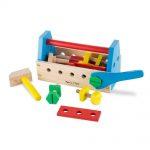
- 4 Must-Have Open-Ended Toys for 3 to 7 year olds –…

- 25 Best Board Games for Kids of All Ages
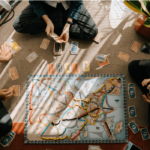
Filed Under: Uncategorized
